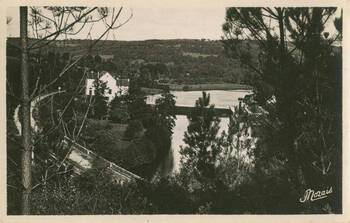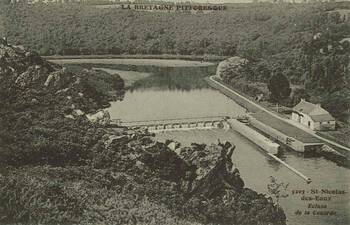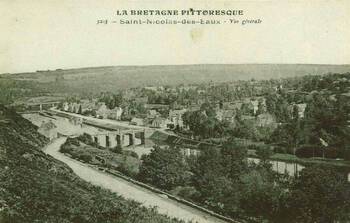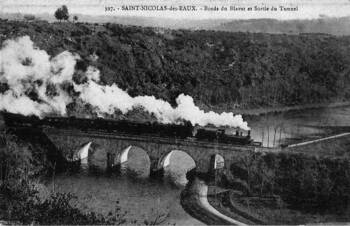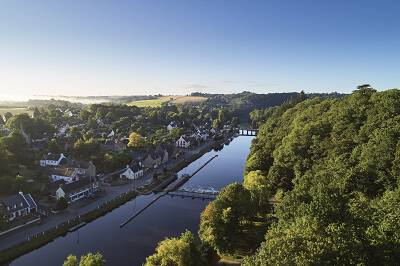Some geography
The Blavet, ar Blavezh in Breton, “gushing water, running water” is a surprising river. Photo : Mairie
It gushes at 280 meters of altitude at the heart of the Argoat in Côtes d’Armor. Then it hurl down the Mené Mounts to have a well-deserved break at Guerlédan’s lake, Brittany’s biggest unnatural lake.
At last it joins the Scorff to throw himself into the sea in Lorient, opposite Port-Louis, the fortress which used to be named as the Blavet. The Blavet invites you to contemplation and sailing during 58 kilometres. You will have to cross 28 locks to reach Hennebont where the river is rocked by the sea sprays.
Many inflows add themselves to the Blavet : Sarre and Brandifout on its right bank in Melrand, then Tarun and Evel on its left bank in Baud.
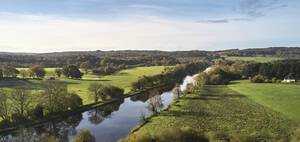
A strategic river
Postcards : www.lecartonvoyageur.fr
The course of the Blavet, largely artificial, has been developed by man for his needs (electricity production, navigation, drinking water supply, flow regulation) over the last two centuries.
In 1785, three citizens, led by Citizen Thistle, travelled by boat from Pontivy to Hennebont to check the possibilities of navigation on the "Blavet". It took them four days to complete this journey, part on the water and part on foot, boat on their backs, to cross fisheries and the dykes of the many mills on the Blavet.
Napoleon 1st, at war with the English, wants to link the town of Pontivy to the "Golphe de Gascogne" via Lorient port-arsenal. In 1802, important canalization works are decided. 27 locks and lock houses and 360 bridges and culverts were built to cross a 54-metre difference in height. At Saint-Nicolas-des-Eaux, the drilling of a tunnel in the hillock allowed the railway line to pass through the valley. The work was completed in 1825. It is the reign of Charles X. On November 4th of the same year, the Blavet Canal was inaugurated with great pomp and circumstance. The boat "Marie-Thérèse" arrives in Pontivy to the applause of the population...

A few years later, a new large-scale project was set up in the valley: the construction of a railway line to link Pontivy more easily to the coast in order to speed up trade. Decided by imperial decree under Napoleon III and inaugurated in 1864, the 53 kilometres of railway line linking Auray to Pontivy required an enormous amount of work, in particular to cross the Blavet by seven bridges and dig two long tunnels. For several years, hundreds of workers (lumberjacks, tree pruners, earthworkers, stone cutters, track layers, etc.) worked on the design of these structures.
The "Napoleon Express" tourist train, which will be back on the rails in the summer of 2021, runs along the Pontivy/Lambel-Camors section with stops in Saint-Nicolas-des-Eaux, Saint-Rivalain and Quistinic. Don't hesitate to come on board, you will discover some fabulous landscapes!
Old postcards : collection Musée de la Carte Postale - BAUD





